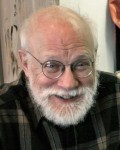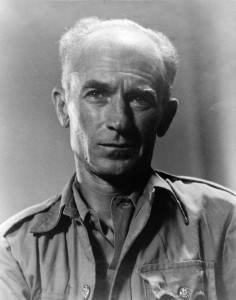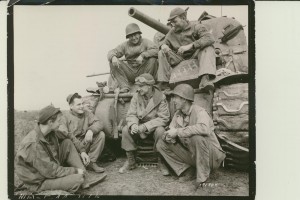Remarks of Owen V. Johnson, Ph.D., for delivery at the 70th anniversary commemoration of the death of Ernie Pyle, near his grave at the National Memorial Cemetery of the Pacific, Punchbowl Crater, Hawaii, April 18, 2015.
Johnson is a professor emeritus of journalism at Indiana University, which the noted war correspondent, an Indiana native, attended. The Ernie Pyle Legacy Foundation organized the ceremony.
The National Society of Newspaper Columns sets every April 18 as National Columnists Day, in honor of Pyle.
Ladies & Gentlemen,
I am honored and humbled to be asked to speak today. Although my intense interest in the life of Ernie Pyle is nearing two decades, I almost feel myself unqualified to speak, especially in the presence of members of Ernie’s family and of people who knew him.
During my studies I’ve come to know Ernie Pyle close up, to see him grow up, go to college. I know about his foibles and his struggles. I’ve met people who knew him. I’ve talked and taught about his work as a war correspondent. I have read his wartime columns. I’ve followed his footsteps in London and Normandy and Paris.
But it’s only standing in this place of beauty and silence and remembrance, in the presence of Ernie Pyle’s earthly remains, that we can feel the full force of what he meant to both the soldiers and sailors who served in World War II, and to the Americans who read his stories.
Tom Brokaw refers to the Greatest Generation. Many of that generation, who are so quickly passing from this earth, would not consider themselves great, or heroes. They were simply doing their duty.
When Ernie Pyle was growing up on the windswept western border of Indiana, he probably never imagined that he would travel to Hawaii, which he did three times, much less that his physical remains would rest here eternally.
Ernie Pyle’s body was first placed in this spot at 9:50 a.m., on July 19, 1949. He was buried together with the four people around him. Ernie would have liked that. The president of the Honolulu Press Club, Buck Buchwach, gave a short eulogy. A three-gun salute was fired. Taps was played.
Pyle would have been embarrassed by this commemoration today. He would have said that he was just one of 500 US war correspondents. He was the last of 54 of them who died during the war. Most significantly, he would say that the almost 300,000 US troops who died in the war were much more important than he was.
This may all be true, Ernie, but you were the one who best told the story of those troops as honestly as you could.
Some of the troops referred to Ernie Pyle as “The Old Man.” That’s because when he went to North Africa in late 1942, he was 42 years old. He had understanding and maturity. He was beyond the gung-ho stage of life.
In truth, Pyle was swept up in 1917 in the rabid patriotic wave that swept over the United States when this country entered World War I. He desperately wanted to enlist, but his parents told him he had to finish high school first.
But as soon as his diploma was in his hand, he enlisted in the Navy. Many people don’t know that, but it says so right here on his grave marker. He undertook basic training in the landlocked city of Champaign, Illinois. He loved doing KP and being on guard duty.
When Pyle entered Indiana University in fall 1919, he looked upon the hundreds of veterans who were enrolling or re-enrolling as heroes. But as he got to know them, he discovered that war is hell. He met young men whose lungs had been scarred for life by poison gas. He heard stories of the terrible violence that is the real face of war.
Ernie left Indiana a semester early to start his journalism career. Within a few months he was in Washington, D.C., covering the government, including the president, in action. By 1928 he was writing aviation news, where he became close friends with such future famous World War II aviation greats as Jimmy Doolittle and Ira Eaker.
In 1935 Pyle started writing a daily column about the things he saw and the people he met as he crisscrossed America. In the process he honed his story-telling abilities, and more importantly got to know America. That experience was priceless when he turned his attention to telling the story of war.
It is remarkable how Ernie Pyle’s wartime columns somehow capture our memories of the war.
In December 1940, he described a German blitz attack “a night when London was ringed and stabbed with fire.” “The thing I shall always remember above all the other things in my life is the monstrous loveliness of that view of London — London stabbed with great fires, shaken by explosions, its dark regions along the Thames sparkling with the pinpoints of white-hot bombs, all of it roofed over with a ceiling of pink that held bursting shells, balloons, flares and the grind of vicious engines … the most hateful, most beautiful single scene I have ever known.”
In North Africa, after a defeat in Tunisia, he wrote, “As for our soldiers themselves, you need feel no shame nor concern about their ability. I have seen them in battle and afterwards and there is nothing wrong with the common American soldier. His fighting spirit is good. His morale is okay. The deeper he gets into a fight the more of a fighting man he becomes.” Then there was “the God-damned infantry as they like to call themselves. They are the mud-rain-frost-and wind boys. They have no comforts, and they even learn to live without the necessities. And in the end they are the guys that wars can’t be won without.”
In Italy he reported that “never have I crossed the trail of any man as beloved as Capt. Henry T. Waskow of Belton, Texas,” and then he painted a picture of his men paying homage: “the first man squatted down, and he reached down and took the dead hand, and he sat there for a full five minutes, holding the dead hand in his own and looking intently into the dead face … And finally he put the hand down, and then reached up and gently straightened the points of the captain’s shirt collar, and then he sort of rearranged the tattered edges of his uniform around the wound. And then he got up and walked away down the road in the moonlight, all alone.”
He described Omaha Beach the day after D-Day: “It was a lovely day for strolling along the seashore. Men were sleeping on the sand, some of them sleeping forever. Men were floating in the water, but they didn’t know they were in the water, for they were dead. The water was full of squishy little jellyfish about the size of your hand. Millions of them. In the center each of them had a green design exactly like a four-leaf clover. The good-luck emblem. Sure. Hell yes.”
He showed us what it was like when he and others came under a mistaken attack by Allied bombers and he dove flat to the ground but didn’t know on which side of a wall to take cover. After the mistake was corrected he stood up and found some of his friends … dead. When he came to Paris he wrote, “I had thought that for me there could never again be any elation in the war. But I had reckoned without the liberation of Paris.
“I remember Ernie Pyle as a man of small stature,” Gen. Eisenhower recalled, “a man of high courage, of great understanding and love for his fellows. I remember him as a reporter who won the devotion of millions merely by writing the familiar everyday facts of life as he saw them. Both in war and in peace Ernie Pyle conceived it his duty to write the truth with the vigor of simplicity. His name is a symbol of integrity in his profession.”
Gen. Omar Bradley understood best what Pyle was doing: “Through his eloquent writing,” he said, “Ernie Pyle managed to take the battlefield to the hearthstone of America. Through his simple stories, he let the people back home know the troubles of the man at the front. This was the gift to those at home who wanted to share, and in doing it he made the load a little lighter for the fighting man and his family.”
Or as the Sons of Indiana put it in 1944, “you give every G.I. the temporary stature of a general; every private soldier becomes, for a day, a hero in his own right through the magic of your humble testimony; paying no mind to ranks and ribbons and maneuvers you are doing a magnificent job of telling the story of a war by ignoring the battles. … The gentle tap-tap of the keys on your rusty portable rises above the din of smoking guns and becomes a reassuring personal message that flashes half-way around the world to renew the spirits of countless mothers and fathers, wives and sweethearts, sisters and brothers and the folks next door.”
We don’t know which of his wartime columns Pyle was most proud of. He didn’t think about such things. But I suspect it would have been his last unfinished one. “Last summer I wrote that I hoped the end of the war could be a gigantic relief, but not an elation. In the joyousness of high spirits it is easy for us to forget the dead. … But there are many of the living who have had burned into their brains forever the unnatural sight of cold dead men scattered over the hillsides and in the ditches along the high rows of hedge. … Dead men by mass production … month after month and year after year. Dead men in winter and dead men in summer. … Dead men in such familiar promiscuity that they become monotonous. Dead men in such monstrous infinity that you come almost to hate them.”
Ernie Pyle could not tell us everything, but he came as close to it as anyone. Today we remember the stories that he and his fellow correspondents told us. We remember the soldiers whose stories he told.
I wish to close my remarks by asking you now in silence to remember them (moment of quiet).
-30-





4 comments for “Pyle Scholar Speaks on 70th Anniversary of Death”